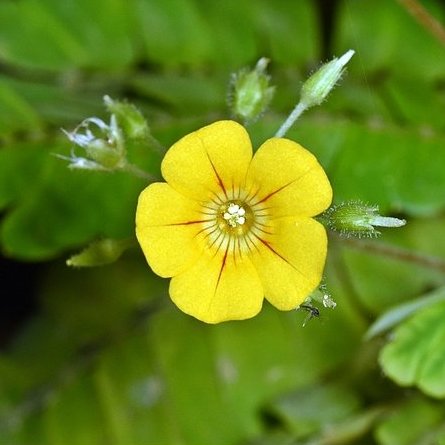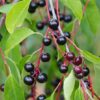Biophytum sensitivum is a fascinating plant that has garnered attention from botanists, naturalists, and plant enthusiasts alike due to its unique characteristics. In this 2000-word description, we will delve deeper into the various aspects of this plant, including its taxonomy, morphology, distribution, ecology, medicinal properties, and cultivation.
Taxonomy
Biophytum sensitivum belongs to the family Oxalidaceae, which comprises approximately 900 species of plants, including herbs, shrubs, and trees. The family is distributed worldwide but is most abundant in tropical and subtropical regions. Other well-known members of the Oxalidaceae family include Oxalis, Averrhoa, and Sorrel.
The genus Biophytum consists of approximately 40 species of plants that are predominantly found in the tropical regions of Asia, Africa, and Australia. The name Biophytum is derived from the Greek words “bios” meaning life and “phyton” meaning plant.
Morphology
Biophytum sensitivum is a small, herbaceous plant that typically grows up to 10-15 cm in height. It has thin, elongated stems that are green in color and bear small, green leaves that are arranged in a rosette pattern. Each leaf is divided into several leaflets that are elliptical in shape and have a serrated margin. The leaflets are sensitive to touch, and when touched, they fold inwards and droop, giving the plant its common name, “sensitive plant.” The reaction is rapid, and the leaflets can fold within a few seconds of being touched. The leaves also have a tendency to droop when exposed to heat or light.
The plant produces small, white or pinkish flowers that are borne on long, slender stalks that emerge from the axils of the leaves. The flowers are hermaphroditic and have five petals and five sepals. The fruit is a capsule that contains several small, black seeds.
Distribution and ecology
Biophytum sensitivum is native to the tropical regions of Africa, Asia, and Australia. It is found in a range of habitats, including open fields, grasslands, forests, and disturbed areas such as roadsides and agricultural lands. The plant prefers moist, well-drained soils and can tolerate both full sun and partial shade.
Biophytum sensitivum is a prolific seed producer, and the seeds are dispersed by wind and water. The plant also spreads through vegetative propagation, whereby stem fragments or leaf cuttings can grow into new plants.
Medicinal properties
Biophytum sensitivum has a long history of use in traditional medicine in many parts of the world. The plant is known for its anti-inflammatory, analgesic, and antioxidant properties and has been used to treat a range of ailments such as fever, cough, wounds, and skin infections.
Recent studies have shown that Biophytum sensitivum extracts contain compounds that have antimicrobial and anti-inflammatory properties. For example, a study conducted in India found that the methanol extract of Biophytum sensitivum had significant antibacterial activity against several pathogenic bacteria, including Staphylococcus aureus and Escherichia coli. Another study conducted in Thailand found that Biophytum sensitivum extracts had anti-inflammatory activity and could reduce inflammation in rats.
Cultivation
Biophytum sensitivum is a relatively easy plant to grow and care for, and it can be grown both indoors and outdoors. The plant requires well-draining soil and prefers indirect or filtered sunlight. In indoor settings, it can be grown in a bright, sunny spot or under fluorescent lights.
Appearance and Characteristics
Though similar in appearance to some other plants, this plant is characterized by its uniquely shaped nodes. The leaf of the little trees has a round shape with a heart-shaped base and cordate apex that are covered with silver hairs, which give it an amazing silvery gleam.
Its flowers have four petals each, but their color varies from light pink to purple, depending on the variety.
If your looking for another sweetheart plant, then have a look at the lovely String of Hearts.
QUICK SUMMARY
- Botanical Plant Name: Biophytum sensitivum
- Native to: Central and South America
- Care: Requires medium to high light and tolerates lower temperatures well.
- Size: Not more than 12 inches tall
How to Care for Little Tree
Once you plant Little trees (Biophytum sensitivum) you need to know how this kind of plant needs to be taken care of. So let’s take a look at some easy steps that will help you with this process.
Sunlight
Place in a bright location, but not direct sunlight. If the plant is too hot, it will begin to die.
Little tree not the ideal plant for you, then check out the leafy Calathea Rufibarba from South America.
Watering
Water sparingly and only when needed during spring/summer months; do not let the soil dry out completely between watering. During fall/winter months, water once weekly or less often if leaves are browning.
Humidity and Temparature
If the plant is given too much humidity (i.e., bathroom location), it will begin to die, so keep away from showers/baths and windowsills where water may collect or drip down into pots. Allow soil to dry out before watering again; during fall/winter months, allow the soil to dry out more often.
Cleaning
To clean, gently wipe leaves and dust off with a soft cloth or use a spray bottle to mist the plant; do not submerge in water as it will cause rot/disease.
Fertilizing and Soil
Fertilize once every two months during spring/summer months and once a month during fall/winter months. Use fertilizer specifically designed for cacti or succulents, such as a 20-20-20 NPK ratio of nitrogen, phosphorus, and potassium, respectively.
Repotting
Repot in early spring before new growth appears or when the plant becomes root bound; repot using the same soil that came with the plant or uses a succulent potting mix.
If your looking for a plant that does not require repotting often then you might think about Maranta Leuconeura.
How and When to Prune Little Tree
If you want to grow this plant indoors, here are some tips on how and when to prune Little trees (Biophytum sensitivum).
Little trees (Biophytum sensitivum) is a plant whose foliage is often used in flower arrangements. It can be pruned when it has grown to about four inches tall and has reached a minimum of four leaves.
The best time to prune is during spring when the plant has begun to grow again after its winter dormancy period.
The plant’s stem should be cut about an inch above its base, making sure the cut is clean. You should prune the plant back to make it more compact and not longer than four inches for aesthetic purposes.
When to prune Little trees (Biophytum sensitivum) will depend on the area where it is grown and its growth pattern. Some plants may need to be pruned in the summer when they grow rapidly, while it might not be necessary for others that grow very slowly.
Problems with Little Tree(BIOPHYTUM SENSITIVUM)
Little trees (Biophytum sensitivum) requires a lot of moisture and will rot if the roots are not moist.
They are very sensitive to drought conditions. Even a couple of days without water will cause the leaves to curl up and dry out.
Little trees (Biophytum sensitivum) is susceptible to root rot and leaf spot in the garden.
How To Propagate Little Tree (BIOPHYTUM SENSITIVUM)
Interestingly, this plant can be easily propagated and cultivated by simply planting its seeds on moist soil and covering it with some substrate, such as sand or peat. It generally takes about one month for Little trees (Biophytum sensitivum) to germinate.











Reviews
There are no reviews yet.